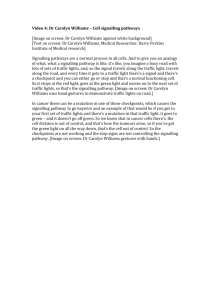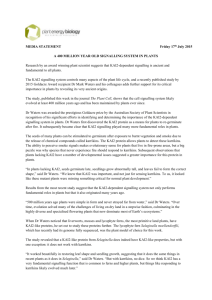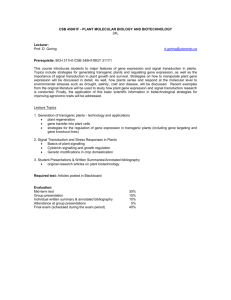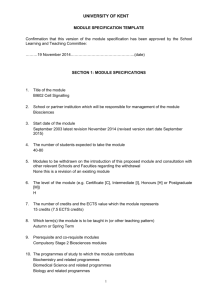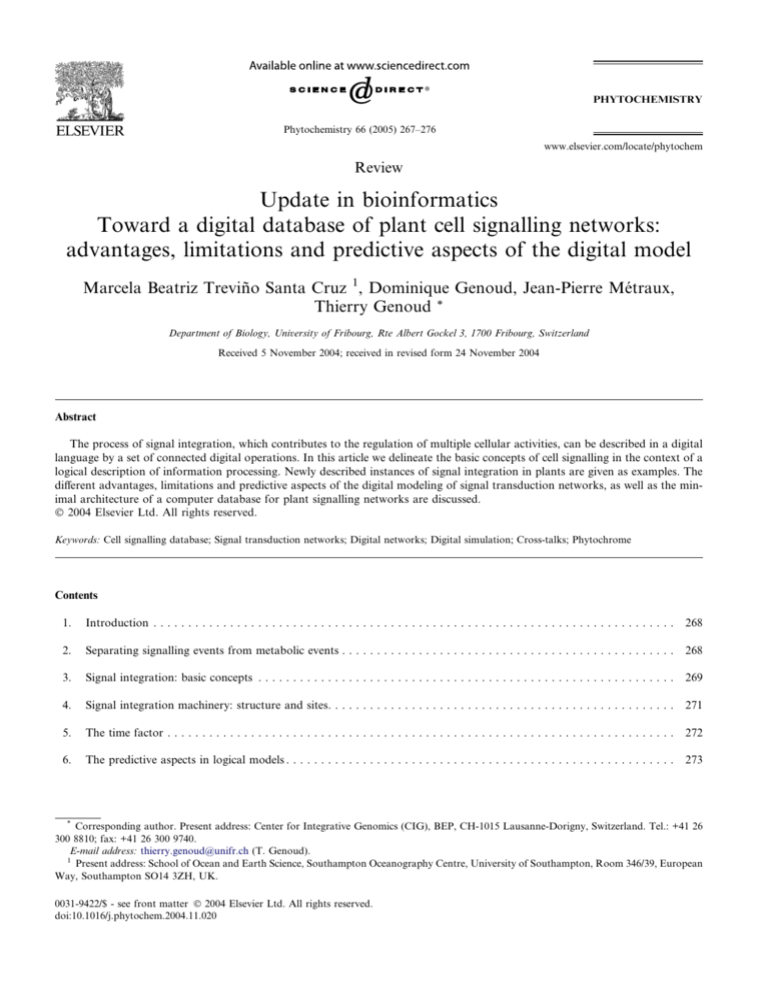
PHYTOCHEMISTRY
Phytochemistry 66 (2005) 267–276
www.elsevier.com/locate/phytochem
Review
Update in bioinformatics
Toward a digital database of plant cell signalling networks:
advantages, limitations and predictive aspects of the digital model
Marcela Beatriz Treviño Santa Cruz 1, Dominique Genoud, Jean-Pierre Métraux,
Thierry Genoud *
Department of Biology, University of Fribourg, Rte Albert Gockel 3, 1700 Fribourg, Switzerland
Received 5 November 2004; received in revised form 24 November 2004
Abstract
The process of signal integration, which contributes to the regulation of multiple cellular activities, can be described in a digital
language by a set of connected digital operations. In this article we delineate the basic concepts of cell signalling in the context of a
logical description of information processing. Newly described instances of signal integration in plants are given as examples. The
different advantages, limitations and predictive aspects of the digital modeling of signal transduction networks, as well as the minimal architecture of a computer database for plant signalling networks are discussed.
Ó 2004 Elsevier Ltd. All rights reserved.
Keywords: Cell signalling database; Signal transduction networks; Digital networks; Digital simulation; Cross-talks; Phytochrome
Contents
1.
Introduction . . . . . . . . . . . . . . . . . . . . . . . . . . . . . . . . . . . . . . . . . . . . . . . . . . . . . . . . . . . . . . . . . . . . . . . . . . .
268
2.
Separating signalling events from metabolic events . . . . . . . . . . . . . . . . . . . . . . . . . . . . . . . . . . . . . . . . . . . . . . . .
268
3.
Signal integration: basic concepts . . . . . . . . . . . . . . . . . . . . . . . . . . . . . . . . . . . . . . . . . . . . . . . . . . . . . . . . . . . .
269
4.
Signal integration machinery: structure and sites. . . . . . . . . . . . . . . . . . . . . . . . . . . . . . . . . . . . . . . . . . . . . . . . . .
271
5.
The time factor . . . . . . . . . . . . . . . . . . . . . . . . . . . . . . . . . . . . . . . . . . . . . . . . . . . . . . . . . . . . . . . . . . . . . . . . .
272
6.
The predictive aspects in logical models . . . . . . . . . . . . . . . . . . . . . . . . . . . . . . . . . . . . . . . . . . . . . . . . . . . . . . . .
273
*
Corresponding author. Present address: Center for Integrative Genomics (CIG), BEP, CH-1015 Lausanne-Dorigny, Switzerland. Tel.: +41 26
300 8810; fax: +41 26 300 9740.
E-mail address: thierry.genoud@unifr.ch (T. Genoud).
1
Present address: School of Ocean and Earth Science, Southampton Oceanography Centre, University of Southampton, Room 346/39, European
Way, Southampton SO14 3ZH, UK.
0031-9422/$ - see front matter Ó 2004 Elsevier Ltd. All rights reserved.
doi:10.1016/j.phytochem.2004.11.020
268
7.
M.B. Treviño Santa Cruz et al. / Phytochemistry 66 (2005) 267–276
Conclusion . . . . . . . . . . . . . . . . . . . . . . . . . . . . . . . . . . . . . . . . . . . . . . . . . . . . . . . . . . . . . . . . . . . . . . . . . . . .
274
References . . . . . . . . . . . . . . . . . . . . . . . . . . . . . . . . . . . . . . . . . . . . . . . . . . . . . . . . . . . . . . . . . . . . . . . . . . . .
274
1. Introduction
During the processing of signals in a cell, multiple
intrinsic and extrinsic information sets are combined
by cellular processors to elicit the most logical/adapted
response for any given conjunction of stimuli. The characterization of signal integration processes emerges as
an important issue in biology, since they control gene
expression, the activity of proteins and motor functions,
the course of development, as well as adjustments of primary and secondary metabolism following the fluctuations of environmental and internal parameters (see
for instance Jordan et al., 2000; Gasch et al., 2000; Cases
et al., 2003). Models for the representation of the cellular control systems have been proposed since the early
1960s (Jacob and Monod, 1961a,b; Kauffman, 1974);
they mostly have considered the regulation of genes as
the output of ‘‘genetic networks’’, i.e. as the result of
the activation of a causal network of genes responsible
for the induction/repression of other genes in a cascade
of events. This connectionist view has been applied on
processes such as the progression of cell differentiation
in animals or the induction of a specific stage during
the course of development (Yuh et al., 1998; Davidson
et al., 2002). In this approach one starts from a mathematical standpoint and uses complex data from the
high-throughput technologies such as microarrays and
large-scale 2-hybrid systems in yeast to infer the minimal
structure of a genetic network (Somogyi and Sniegoski,
1996; DÕhaeseleer et al., 1998, 2000; Thieffry, 1999;
Guelzim et al., 2002; Shen-Orr et al., 2002; Alon,
2003; Bray, 2003; Wuchty et al., 2003). On the other
hand, the creation of dynamic models allowing computer representation and analysis has been the object
of multiple theoretical studies (reviewed in De Jong,
2002). Differential equations and models such as Petri
networks and Bayesian networks have been applied to
complex biological networks of interacting cell components, with some exciting achievements (e.g. the lambdaphage activation cycle, McAdams and Shapiro, 1995;
the MAP kinase cascade, Bhalla et al., 2002). Globally,
the modeling methods can be divided into two main
groups; one providing a qualitative description, the
other capitalizing on statistical variations and/or random factors embedded in cell signalling operators.
These operators are described in the first case as simple
processors adding or associating unitary signals to
create a new signal (connected in logical/Boolean networks; Thomas, 1973); and in the second case, as processors enclosing continuous or probabilistic values,
yet equally rooted on the same logical rules of association (connected in statistical Boolean networks, Bayesian networks, or sets of differential equations; reviewed
in De Jong, 2002; Bolouri and Davidson, 2002; discussed in Shmulevich et al., 2002).
A graphic digital model has been proposed for the
description of signal transduction networks in plants
(Genoud and Métraux, 1999; Zhang and Shapiro,
2002; Heck et al., 2003; Thum et al., 2003). This model
can be used to create a common formalism for a plant
signalling database to be included in a database ontology, [such as the EcoCyc ontology (Karp et al., 2002),
RzhetskyÕs ontology (Rzhetsky et al., 2000), the Biological Process Ontology (The Gene Ontology Consortium,
2001), BhallaÕs ontology (Bhalla, 2002), the BioPax
ontology (http://www.biopax.org)], and expressed in a
format for data exchange (e.g. SBML, Systems Biology
Markup Language). It is also very suitable for the qualitative simulation of plant responses using computers. In
this article we describe some basic features of biological
signal processing that may serve for the identification of
signalling proteins based on their sequence, structure,
and biochemical properties. We also discuss the limitations of a digital model versus more quantitative models
to represent and simulate the basic properties of plant
signal processing, and propose the creation of a signalling database for plant biologists using a digital paradigm. Such a tool will be very helpful in plant
signalling research, where results obtained from studies
in different plant species and under a wide range of
developmental and experimental conditions often make
data interpretation challenging. By using digital models
and including all relevant information in a comprehensive database, the use of available information could
be optimized, so that a clearer and more complete picture of cell signalling events may emerge.
2. Separating signalling events from metabolic events
The idea of a ÔsignalÕ is central in the science of information, and therefore in any model of cell information
processing. This notion contains a priori meanings that
deserve to be shortly recapitulated here, since they bias
M.B. Treviño Santa Cruz et al. / Phytochemistry 66 (2005) 267–276
the definition of signal transduction activity, and therefore the representation of such an activity in a specific
database. First, the notion of a signal tacitly separates
the activity of perception from the activity of cyclic
and constant modifications of the basic metabolism
(the metabolome). The notion of a signal also contains
the idea of a unit of induction; e.g. a defined quantity
of stimulus generating a detectable physiological and/
or molecular response, the significance of which is statistically determined. In the frame of a digital model of signalling, one statistically significant signal leads to a
response with an assigned value of one (1). For a complete description of cell signalling, this basic definition
of signal could be inadequate in several cases. For instance, some metabolic events also possess signalling
properties (e.g. the function of hexokinase in sugar sensing, Jang et al., 1997; the role of aconitase as an iron
sensor, Navarre et al., 2000; the acetyl-c-glutamyl
phosophate reductase Arg5,6, acting as a transcription
factor; Hall et al., 2004); and in a systemic view any
event connected to a regulatory loop might be regarded
as a potential signal emitter. In addition, any change in
the threshold of significance assigned to a biological response affects the level of the corresponding input signals. This may produce qualitative changes in the
digital model and will require modifications in the details of such a representation. The construction of a
large database of cellular signalling and responses must
therefore include a precise description of the thresholds
of significance (statistical values) and of all experimental
conditions (see Fig. 1). Moreover, since the notion of
signal implies observable biological changes, any exchange of information among processes controlling the
cellular homeostasis and leading to no apparent changes
in metabolite concentration or gene expression, would
escape the definition of signalling and thus would be
improperly neglected. Therefore, access to metabolic
databases and to the related genetic data obtained from
specific mutants in the metabolic pathways should be included in order to compensate for the missing information (Fig. 1).
3. Signal integration: basic concepts
Signal integration can be understood as a process by
which two or more signals interact with a biochemical
component and thereby create a new ‘‘output’’ signal
(Monod and Jacob, 1961; Sugita, 1961, 1975; Walter
et al., 1967; Kauffman, 1974; Prehoda and Lim, 2002).
The operation of such a process requires a minimal set
of stable and characteristic constraints. The concept of
a molecular operator integrating several signals is not
trivial, as it presupposes complex molecular structures
capable of carrying out sophisticated biochemical functions (see for instance the regulation of genes during sea
269
urchin development: Arnone and Davidson, 1997; Yuh
et al., 1998, 2001; the N-WASP function: Prehoda and
Lim, 2002; Dueber et al., 2003). It is useful to shortly
re-examine the basic necessary properties for the integration of cellular signals by a biochemical component
in the light of a graphic digital representation and of recent biochemical discoveries.
The biochemical machinery of signal integration is
experimentally robust (i.e. statistically reproducible),
and must include a minimal number of stable rules of
signal association. The way in which such combination
rules may be embodied in a molecular signalling element
has been the object of recent experimental investigations
(Russo et al., 1996; Prehoda et al., 2000; Tarricone et al.,
2001; Dueber et al., 2003). From the point of view of a
basic theoretical approach, rules of signal transduction
and/or integration might be compared to the concept
of a translation system. Such a molecular system contains two main features: a recognition and memory ability of the input signal(s) to be translated (located in the
input domain), and a mechanism for generating a response, or output signal, (which is the result of translation), e.g. a connection toward secondary components,
such as the next element in a signalling network. For instance, the key-lock recognition of a substrate by an enzyme corresponds to the input perception step that
implies a stereochemical memory of the substrate. In
contrast, the catalytic activity of the enzyme generates
the output of translation. Both aspects constitute the
operation of this molecular translator. In general, the
different features of a translation rule can be described
in a qualitative manner. For example, the biochemical
phenomenon of molecular recognition, which implies a
molecular memory, relates to the specific and distinctive
qualitative characteristics of the interacting partners.
Thus a molecular interaction can be represented within
a qualitative model, and the quantitative features of
the interaction may be described discontinuously by several qualitative steps. The mechanism, as well as the output of a molecular operation, can also be digitalized. In
fact, similarly to the arithmetical rules of addition and
multiplication, it is possible to represent in a qualitative
manner any mechanism associating two or more qualities to produce one or more new qualities (as already
shown by Boole, 1854; Von Neumann, 1951). In a dynamic simulation program, this implies however that
the activation of an operator located in a cascade of
integration occurs, for instance, through variation of
the input frequency, a feature that can be easily implemented in current digital simulation programs (Genoud
et al., 2001, 2003).
Biochemical functions can be qualitatively described
by the statistically most relevant steps involved in biochemical reactions such as hydrolysis, addition of residues, reduction, oxidation, allosteric modification of
structures and activity, etc. Indeed, such transformations
270
M.B. Treviño Santa Cruz et al. / Phytochemistry 66 (2005) 267–276
Fig. 1. Schematic representation of the architecture of a cell signalling database that includes a digital simulation program. The information that
would be accessible by clicking on the different objects, and the links to other databases are described in text boxes. Arrows represent transitions
between windows and computer applications. Text in italics corresponds to the options included in a digital simulation program such as DigSim.
A,B: input elements (e.g. receptors); K,L,M: signalling elements (e.g. kinases).
imply either alterations in spatial qualities (tri-dimensional structure) or qualitative changes (variation of
chemical properties). Qualitative models are therefore
amenable for the representation of large networks of
biochemical information processing. Digital models
have been shown to be suitable for the description of cell
signalling processes (Genoud and Métraux, 1999; Genoud et al., 2001; Zhang and Shapiro, 2002; Thum
et al., 2003). Such models use defined categories for
the input and output signals and unitary association
rules that cover any possible logical combination, and
that can be directly applied in a logical simulation program (for instance inside the MatlabÕs Simulink application). However, the fine details of enzyme kinetics and
protein stability, or those of the relative affinity for specific interacting factors, would need to be simplified into
their statistically most significant components. Hence, a
qualitative digital model would be appropriately
M.B. Treviño Santa Cruz et al. / Phytochemistry 66 (2005) 267–276
completed by quantitative parameters measured for the
individual components of signal transduction networks,
e.g. the in vitro measurements of enzyme kinetics. This
additional information should be directly accessible
from the digital model to give researchers the possibility
of designing further experiments to target particular aspects of the cell signalling component (see Fig. 1).
For the digital representation, gene expression can be
described as an all or none response and thus translated
into an ON/OFF state. However, if needed, a description through categories of expression levels can also be
used. This is a simple way to transcribe quantitative effects into a digital language. While the definition of distinct levels of expression as separate qualities in the
output domain of a signalling network (i.e. categories
such as ÔlowÕ, ÔmediumÕ, ÔhighÕ, and Ôvery highÕ levels of
gene expression) will increase the accuracy of a qualitative model, it could still not provide the level of precision
of a quantitative description that uses, for instance, a
continuous model of differential equations (Lee et al.,
2003).
An additional difficulty may arise with the interpretation of gene expression levels, since feedback of gene
products on their own expression (or autocatalytic effects) might blur the interpretation of signalling circuits.
This might be critical for the inference of genetic networks from microarray data, since different levels of a
geneÕs expression may correspond to the output of distinct circuits in a signalling network.
It is likely that quantitative data characterizing the
behavior of each component controlling gene expression
in a higher organism will not be available before several
decades (Endy and Brent, 2001), and a fully quantitative
model of signalling networks might not be realizable
without a huge computer facility (Kitano, 2002). Until
these data and technologies are available, a qualitative
model seems appropriate.
271
chronized signalling activity, and therefore as continuous quantitative data. The digital model is not able to
represent such a statistical property and therefore does
not reflect the nonsynchronization of, for instance, an
equal response in different cells of a tissue, or the cellular
noise that produces randomness in gene expression levels (Thattai and van Oudenaarden, 2001; Elowitz et al.,
2002). However, transcriptional noise can be evaluated
experimentally (Blake et al., 2003), and simulated using
a generator of variable random values coupled to the
data inputs (Fig. 2(a)).
What are the molecular characteristics of the cell
information processors? It seems obvious that the simplest molecular machines are composed of one or several
complex molecules such as proteins, nucleic acids, or a
combination of both. Fundamentally there are two main
alternatives to operate signal integration:
1) The integration is simple: one logical operator per
molecule, or per complex of molecules. This is the
case of proteins such as N-WASP and Cdk2 (Prehoda and Lim, 2002), the CDK inhibitor (Nash et
al., 2001), and the neural coincidence detectors
(Bourne and Nicoll, 1993).
2) The integration is multiple: several connected operators per molecule or complex of molecules. This
situation is typically found in the case of promoters
containing several cis-regulatory domains (Arnone
and Davidson, 1997; Yuh et al., 2001).
4. Signal integration machinery: structure and sites
Theoretically, there is a stoichiometric proportion
linking the input signals to the activity of a molecular
operator. In fact, the first characterized signal integrators in biological systems associate two signals to a response event with a one-to-one stoichiometry (see for
instance Prehoda and Lim, 2002; Mangan and Alon,
2003). Biochemical experiments have shown that the
molecular machinery required to perform such a simple
association is already highly complex. Hence, the simplest and perhaps energetically most economical way
for a living organism to integrate biochemical information, may be through discrete biochemical associations.
However, since most experimental results are derived
from the observation of numerous signalling molecules,
the data always appear as a statistical sum of unsyn-
Fig. 2. Implementation of noise and clock signals on a digital
simulator. The right panels contain the time signatures of the input
and output signals represented on the left panels, using an arbitrary
time scale (x-axis) for the signal value (y-axis). (a) In this example, a
digital signal has been associated to a source of random signal through
an adder in order to simulate biological noise; the amplitude of the
random signal can be adjusted to simulate measured signalling
background. (b) The activation of an oscillating clock-like signal has
been placed under the control of a simple ON/OFF switch (input 1)
through an AND operator. (Similarly, several signals may be
connected to a central clock in order to simulate circadian rhythms).
272
M.B. Treviño Santa Cruz et al. / Phytochemistry 66 (2005) 267–276
The site of signal integration can be found at diverse
locations throughout a signalling network. In fact two
pathways may interact several times at different levels,
such as at the level of hormone production, of histone
modifications that mediate changes in chromatin configuration, of promoter activity, etc. To illustrate this fact
it is useful to consider examples of signal integration recently described in plants.
For instance, evidence suggests that multiple connections exist between the phytohormone auxin and the
phytochrome-mediated regulatory networks. OÕGrady
et al. (2001) identified in soybean plants a novel member
of the GT-2 family of transcription factors, namely
GmGT-2, which unlike other family members, was
shown to be transcriptionally down-regulated by light
in a phytochrome-dependent manner. As with GmGT2, RNA-level analysis indicated that transcription of
Aux28, a member of the Aux/IAA family of auxinresponsive genes encoding short-lived transcription factors, is also negatively regulated by phytochrome. Using
electrophoretic mobility shift assays, GmGT-2 was demonstrated to bind to well-mapped protein binding sites
in the promoter region of Aux28, suggesting that the
transcriptional control of this Aux/IAA gene by phytochrome may be mediated by transcription factors such
as GmGT-2. On the other hand, the promoter region
of Aux28 also contains elements similar to those responsible for the auxin-induced expression of the GH3 gene,
mediated by another class of transcription factors involved in auxin responsiveness, known as ARFs. Both
Aux/IAA proteins and ARFs contain conserved domains that enable their intra- and interfamily dimerization (Kim et al., 1997; Ulmasov et al., 1999). As
indicated by OÕGrady et al. (2001), it remains to be
determined whether the observed phytochrome-mediated regulation of the Aux28 gene occurs through a
reduction in auxin levels, through the down-regulation
of positive activators such as GmGT-2 and ARFs, or
both. At least for some Arabidopsis and pea Aux/IAA
recombinant proteins (e.g. SHY2/IAA3 and Ps-IAA4),
their interaction with and phosphorylation by recombinant phytochrome A (phyA) from oat has been shown
in vitro (Colon-Carmona et al., 2000). This group of
researchers also demonstrated increased in vivo steadystate levels of mutant IAA3 in shy2-2 gain-of-function
mutant plants, and in vivo phosphorylation of the
SHY2-2 protein, leading them to propose the phytochrome-dependent phosphorylation of Aux/IAA proteins as a molecular mechanism for integration of light
and auxin signalling.
A different type of cross-talk juncture between these
two signalling pathways has been described in Arabidopsis by Hsieh et al. (2000), involving FIN219, a novel
phyA signalling component. fin219 was identified as a
suppressor mutation of cop1-6 during a screen for genes
involved in the light-induced inactivation of COP1.
COP1 is a key repressor of photomorphogenic development known to be primarily controlled by phyA, phyB,
and cryptochromes, and it is thought to negatively regulate transcription factors involved in light-regulated
gene expression, presumably by targeting them for degradation by the 26S proteasome (Osterlund et al., 2000).
FIN219 shows homology to the GH3 protein family,
and as is the case for this protein family of yet unknown
function, its expression is rapidly induced by auxin.
Since the auxin-regulated processes in the fin219 mutant
are not altered, it is unlikely for FIN219 to be an auxinsignalling component. Therefore, this may be an example of cross-talk in which auxin regulates the expression
level of a light signalling component. Taken together,
these and other lines of evidence suggest the existence
of complex and plastic interactions between the lightand auxin-mediated regulatory networks.
Yet a different type of regulation exists where one
operator modulates two distinct pathways. For example,
a recent study in Arabidopsis reveals the regulation of
ABA- and phyA-mediated germination responses to be
affected by a common modulator (Duque and Chua,
2003). This seed imbibition-inducible modulator,
IMB1, is a member of the BET subgroup of bromodomain-containing proteins, a class of putative transcriptional regulators whose mode of action is thought to
involve their association with acetylated histones (Florence and Faller, 2001). IMB1 appears to be specific to
the promotion of seed germination, and it negatively
and positively regulates the ABA and phyA transduction pathways, respectively. This is an interesting case
from the emerging field of chromatin remodeling.
5. The time factor
The concentration of a protein/nucleic acid(s) processor can fluctuate in time and this in turn might alter the
characteristics of the corresponding logical element in
the model. Moreover, if such variation in concentration
induces the emergence of new responses, an additional
digital element must be defined and associated with that
particular protein/nucleic acid(s) processor. These are
inconveniences of a dynamic digital representation that
need to be solved before the construction of a database.
In fact, continuous systems of oscillation are found at
organismic and cellular levels (Goldbeter, 2002; Eriksson and Millar, 2003). They are composed of series of
biochemical events subjected to transient negative feedback loops that may interrupt the expression of a particular gene responsible for cycling processes. A digital
description of complex organized cellular events must
consider the input of the cycling processes as a clock-like
input. The cellular equivalent of a digital clock, which
can define the tempo (or phase) of the diverse signal
integration cascades, must be a chemical oscillation sys-
M.B. Treviño Santa Cruz et al. / Phytochemistry 66 (2005) 267–276
tem consisting of rapid fluctuations in the level of a
small diffusable cellular component. Calcium ions and
protons are possibly involved in such pacemaker functions, as they are known to modulate countless biochemical processes, including the regulation of
enzymatic activities. For example, the concentration of
calcium ions could influence the activity of several signalling proteins, either directly by steric modification
(of, for instance, calcium-dependent protein kinases)
or indirectly through the mediation of calcium-binding
proteins such as calmodulins, calcitonins, annexins,
phosphatases, etc., which in turn modulate other proteins involved in signalling (Johnson et al., 1995; Trewavas and Malho, 1998). Rapid diffusion waves of a
chemical species such as Ca2+ may accompany the transduction of signals, or may be constitutively pulsing in
the cytoplasm to coordinate the phase aspect of signal
transduction (Guo et al., 2002; Nishida et al., 2003).
The formation of additional and/or new organizing
waves at the time of signal perception may reinforce
or reduce the basic pacemaker process in order to
emphasize important incoming information. Therefore,
very accurate modeling of cell signals would require
the addition of one or several clock oscillators for the
synchronization of the signalling events. This is easily
implemented in digital simulators that contain clock-like
input sources (see Fig. 2(b)). These elements can be connected to any signalling operations in order to generate
an oscillating output upon activation by an input signal.
In fact, the digital networkÕs language allows dissection of cycling loops such as the circadian oscillation
of gene expression. Dynamic representation and adaptation of input settings from a specific computer window
will permit the construction of accurate models and a
useful analysis of cycling cellular events (such as for
example mitosis).
273
The simplest case of a postulate is the statement that
a certain result, for instance an experimental observation, is reproducible in a given context, i.e. that it will
occur in the same given way as long the prescribed
conditions are met. This is the property of any model
or knowledge database. Two different cases of postulate arise when: (1) two sets of data containing the
same output response are superimposed and connected,
and (2) when a single data set is obtained by the effect
of 2 stimuli acting on a system simultaneously, but not
when acting in an alternate manner. In these last two
cases a prediction may result in fact from the insertion
of putative logical operators into a synthetic model.
This is illustrated in Fig. 3 with an example of the first
case (superimposition of data), where two stimuli (a
and b) have been applied independently to the same
system, and both give the response X. Joining inputs
a and b to output X in a model (for instance using
an OR operator), even though the effects of a and b
when applied in conjunction are not known, represents
a prediction. This can subsequently be tested by an
experiment, where stimuli a and b are applied together
to possibly produce a second response different from
6. The predictive aspects in logical models
The representation of signalling networks using digital operators has the power of a precise language. However, digital networks will always contain some
simplifications and assumptions, since this knowledge
is rarely/never complete. In fact, such gaps provide the
predictive quality of the qualitative model: any knowledge in the absence of the complete details represents
a series of postulates or expectations. The apparent
determinism of the sets of logical operations represented
in digital models has in fact a probabilistic nature, and
includes uncertainty at every level. Moreover, inherent
variations in experimental measurements produce noise,
which add uncertainty to the model. However, because
the predictive power of a digital model can be a matter
of controversy, and because prediction is central to science, this point deserves the following comment.
Fig. 3. The predictive aspect in a digital circuit is a function of the
available data. In panel (a), the qualitative information (1 = ON,
0 = OFF) corresponding to the effect of two different input signals
(a,b) is incomplete, the result of a simultaneous treatment with both a
and b being unknown. (b) A combinatorial set of data provides the
complete qualitative information to design digital circuits. The result
of the effect of a + b is known, the postulated Boolean element can be
replaced by a different operator (XOR). The circuit has now a higher
predictive power for the effect of the two possible inputs: it can fully
simulate the observed output in function of any combination of inputs
a and b.
274
M.B. Treviño Santa Cruz et al. / Phytochemistry 66 (2005) 267–276
the one postulated. In the case represented in Fig. 3,
the OR operator linking a and b, must be changed into
an XOR operator. Thus, an interesting feature of digital logic dwells in its flexibility and versatility: it provides the possibility of substituting basic operators
such as NOT, AND, OR by a combination of NOR,
and/or NAND gates, or of replacing any operator with
the same given number of inputs by an operator of different logic without changing the complete network.
Usually, the predictive/speculative aspects of a digital
system correspond to specific confined structures in a
network (the results of additional experiments will only
modify part of the network), and providing the possibility of confirmation and improvement by further targeted experiments (Ideker et al., 2000; Bolouri and
Davidson, 2002).
7. Conclusion
In this article we discuss some basic concepts of signal
integration in the context of cell biology, showing that a
very precise description of experimental results can be
provided by a digital computing framework. This digital
model appears presently as a conveniently accessible
ontological formalism for the representation of signalling networks. It offers an easily readable overview, it
can be readily improved through alterations made to
fit new knowledge, and it can also take into account kinetic and quantitative aspects of signalling networks.
This model could therefore be amenable for the general
framing of a signalling database. Such a database should
include easy access to all available quantitative information, such as genetic data (e.g. Mendelian characters of a
mutation), experimental parameters, topological data
(e.g. protein localization), biochemical characteristics
(in vitro measurement of kinetics, and in vivo concentration of signalling components), etc., in order to provide
plant biologists with the best tools for signal integration
analyses.
References
Alon, U., 2003. Biological networks: the thinkerer as an engineer.
Science 301, 1866–1867.
Arnone, M.I., Davidson, E.H., 1997. The hardwiring of development:
organization and function of genomic regulatory systems. Development 124, 1851–1864.
Bhalla, U.S., 2002. The chemical organization of signalling interactions. Bioinformatics 17, 829–837.
Bhalla, U.S., Ram, P.T., Iyengar, R., 2002. MAP kinase phosphatase
as a locus of flexibility in a mitogen-activated protein kinase
signalling network. Science 297, 1018–1023.
Blake, W.J., Kaern, M., Cantor, C.R., Collins, J.J., 2003. Noise in
eucaryotic gene expression. Nature 422, 633–637.
Bolouri, H., Davidson, E.H., 2002. Modeling transcriptional regulatory networks. BioEssays 24, 1118–1129.
Boole, G., 1854. An Investigation of the Laws of Thought on which
are Founded the Mathematical Theories of Logic and Probabilities. MacMillan and Co., Cambridge.
Bourne, H.R., Nicoll, R., 1993. Molecular machines integrate coincident synaptic signals. Cell 72, 65–75.
Bray, D., 2003. Molecular networks: the top-down view. Nature 301,
1864–1865.
Cases, I., de Lorenzo, V., Ouzounis, C.A., 2003. Transcription
regulation and environmental adaptation in bacteria. Trends
Microbiol. 11, 248–253.
Colon-Carmona, A., Chen, D.L., Yeh, K.C., Abel, S., 2000. Aux/IAA
proteins are phosphorylated by phytochrome in vitro. Plant
Physiol. 124, 1728–1738.
Davidson, E.H., Rast, J.P., Oliveri, P., Ransick, A., Calestani, C.,
Yuh, C.-H., Minokawa, T., Amore, G., Veronica, H., ArenasMena, C., Otim, O., Brown, C.T., Livi, C.B., Lee, P.X., Revilla, R.,
Rust, A.G., Pan, Z.J., Schilstra, M.J., Clarke, P.J.C., Arnone, M.I.,
Rower, L., Cameron, R.A., McClay, D.R., Hood, L., Bolouri, H.,
2002. A genomic regulatory network for development. Science 295,
1669–1678.
De Jong, H., 2002. Modeling and simulation of genetic regulatory
systems: a literature review. J. Comput. Biol. 9, 67–103.
DÕhaeseleer, P., Liang, S., Somogyi, R., 2000. Genetic network
inference: from co-expression clustering to reverse engineering.
Bioinformatics 16, 707–726.
DÕhaeseleer, P., Wen, X., Fuhrman, S., Somogyi, R., 1998. Mining the
gene expression matrix: inferring gene relationships from largescale gene expression data. In: Paton, R.C., Holcombe, M. (Eds.),
Information Processing in Cells and Tissues. Plenum Press, New
York, pp. 203–212.
Dueber, J.E., Yeh, B.J., Chak, K., Lim, W.A., 2003. Reprogramming
control of an allosteric signalling switch through modular recombination. Science 301, 1904–1908.
Duque, P., Chua, N.-H., 2003. IMB1, a bromodomain protein
induced during seed imbibition, regulates ABA- and phyAmediated responses of germination in Arabidopsis. Plant J. 35,
787–799.
Elowitz, M.B., Levine, A.J., Siggia, E.D., Swain, P.S., 2002. Stochastic
gene expression in a single cell. Science 297, 1183–1186.
Endy, D., Brent, R., 2001. Modelling cellular behaviour. Nature 409,
391–395.
Eriksson, M.E., Millar, A.J., 2003. The circadian clock. A plantÕs best
friend in a spinning world. Plant Physiol. 132, 732–738.
Florence, B., Faller, D.V., 2001. You BET-cha: a novel family of
transcriptional regulators. Front. Biosci. 6, d1008–d1018.
Gasch, A.P., Spellman, P.T., Kao, C.M., Carmel-Harel, O., Eisen,
M.B., Storz, G., Botstein, D., Brown, P.O., 2000. Genomic
expression programs in the response of yeast cells to environmental
changes. Mol. Biol. Cell 11, 4241–4257.
Genoud, T., Métraux, J.-P., 1999. Crosstalks in plant cell signalling:
structure and function of the genetic network. Trends Plant Sci. 4,
503–507.
Genoud, T., Trevino Santa Cruz, M.B., Métraux, J.-P., 2001. Numeric
simulation of plant signalling networks. Plant Physiol. 126, 1430–
1437.
Genoud, T., Trevino Santa Cruz, M.B., Métraux, J.-P., 2003.
Networks of cellular information processing: digital description
and simulation. Curr. Genomics 4, 27–36.
Goldbeter, A., 2002. Computational approaches to cellular rhythms.
Nature 420, 238–245.
Guelzim, N., Bottani, S., Bourgine, P., Képès, F., 2002. Topological
and causal structure of the yeast transcriptional regulatory
network. Nat. Genet. 31, 60–63.
Guo, Y., Xiong, L., Song, C.P., Gong, D., Halfter, U., Zhu, J.K.,
2002. A calcium sensor and its interacting protein kinase are global
regulators of abscisic acid signalling in Arabidopsis. Dev. Cell. 3,
233–244.
M.B. Treviño Santa Cruz et al. / Phytochemistry 66 (2005) 267–276
Hall, D.A., Zhu, H., Zhu, X., Royce, T., Gerstein, M., Snyder, M.,
2004. Regulation of gene expression by a metabolic enzyme.
Science 306, 482–484.
Heck, S., Grau, T., Buchala, A., Métraux, J.-P., Nawrath, C., 2003.
Genetic evidence that expression of NahG modifies defence pathways independent of salicylic acid biosynthesis in the ArabidopsisPseudomonas syringae pv. tomato interaction. Plant J. 36, 342–352.
Hsieh, H.L., Okamoto, H., Wang, M., Ang, L.H., Matsui, M.,
Goodman, H., Deng, X.W., 2000. FIN219, an auxin-regulated
gene, defines a link between phytochrome A and the downstream
regulator COP1 in light control of Arabidopsis development. Genes
Dev. 14, 1958–1970.
Ideker, T.E., Thorsson, V., Karp, R.M., 2000. Discovery of regulatory
interactions through perturbation: inference and experimental
design. In: Altman, R.B., Lauderdale, K., Dunker, A.K., Hunter,
L., Klein, T.E. (Eds.), Proc. Pac. Symp. Biocomput. (PSB 2000),
vol. 5. World Scientific Publishing, Singapore, pp. 302–313.
Jacob, F., Monod, J., 1961a. Genetic regulatory mechanisms in the
synthesis of proteins. J. Mol. Biol. 3, 318–356.
Jacob, F., Monod, J., 1961b. On the regulation of gene activity. Cold
Spring Harb. Symp. Quant. Biol. 26, 193–211.
Jang, J.C., Leon, P., Zhou, L., Sheen, J., 1997. Hexokinase as a sugar
sensor in higher plants. Plant Cell 9, 5–19.
Johnson, C.H., Knight, M.R., Kondo, T., Masson, P., Sedbrook, J.,
Haley, A., Trewavas, A., 1995. Circadian oscillations of cytosolic
and chloroplastic free calcium in plants. Science 269, 1863–1865.
Jordan, J.D., Landau, E.M., Iyengar, R., 2000. Signalling networks:
the origins of cellular multitasking. Cell 103, 193–200.
Karp, P.D., Riley, M., Saier, M., Paulser, I.T., Collado-Vides, J.,
Paley, S.M., Pellegrini-Toole, A., Bonavides, C., Gama-Castro, S.,
2002. The EcoCyc Database. Nucleic Acids Res. 30, 56–58.
Kauffman, S.A., 1974. The large-scale structure and dynamics of gene
control circuits: an ensemble approach. J. Theor. Biol. 44, 167–190.
Kim, J., Harter, K., Theologis, A., 1997. Protein–protein interactions
among the Aux/IAA proteins. Proc. Natl. Acad. Sci. USA 94,
11786–11791.
Kitano, H., 2002. Computational systems biology. Nature 420, 206–210.
Lee, E., Salic, A., Krüger, R., Heinrich, R., Kirschner, M.W., 2003.
The roles of APC and axin derived from experimental and
theoretical analysis of the Wnt pathway. PLoS Biol. 1, 116–132.
Mangan, S., Alon, U., 2003. Structure and function of the feedforward loop network motif. Proc. Natl. Acad. Sci. USA 100,
11980–11985.
McAdams, H.H., Shapiro, L., 1995. Circuit simulation of genetic
networks. Science 269, 650–656.
Monod, J., Jacob, F., 1961. General conclusions: teleonomic mechanisms in cellular metabolism, growth, and differentiation. Cold
Spring Harbor Symp. Quant. Biol. 26, 389–401.
Nash, P., Tang, X., Orlicky, S., Chen, Q., Gertler, F.B., Mendenhall,
M.D., Sicheri, F., Pawson, T., Tyers, M., 2001. Multisite phosphorylation of a CDK inhibitor sets a threshold for the onset of
DNA replication. Nature 414, 514–521.
Navarre, D.A., Wendehenne, D., Durner, J., Noad, R., Klessig, D.F.,
2000. Nitric oxide modulates the activity of tobacco aconitase.
Plant Physiol. 122, 573–582.
Nishida, M., Sugimoto, K., Hara, Y., Mori, E., Morii, T., Kurosaki,
T., Mori, Y., 2003. Amplification of receptor signalling by Ca2+
entry-mediated translocation and activation of PLCgamma2 in B
lymphocytes. EMBO J. 22, 4677–4688.
OÕGrady, K., Goekjian, V.H., Naim, C.J., Nagao, R.T., Key, J.L.,
2001. The transcript abundance of GmGt-2, a new member of the
GT-2 family of transcription factors from soybean, is downregulated by light in a phytochrome-dependent manner. Plant Mol.
Biol. 47, 367–378.
Osterlund, M.T., Hardtke, C., Wei, N., Deng, X.W., 2000. Targeted
destabilization of HY5 during light regulated development of
Arabidopsis. Nature 405, 462–466.
275
Prehoda, K.E., Scott, J.A., Dyche Mullins, R., Lim, W.A., 2000.
Integration of multiple signals through cooperative regulation of
the N-WASP-Arp2/3 complex. Science 290, 801–806.
Prehoda, K.E., Lim, W.A., 2002. How signalling proteins integrate
multiple inputs: a comparison of N-WASP and Cdk2. Curr. Opin.
Cell Biol. 14, 149–154.
Rzhetsky, A., Koike, T., Kalachikov, S., Gomez, S.M., Krauthammer,
M., Kaplan, S.H., Kra, P., Russo, J.J., Friedman, C., 2000. A
knowledge model for analysis and simulation of regulatory
networks. Bioinformatics 16, 1120–1128.
Russo, A.A., Jeffrey, P.D., Pavletich, N.P., 1996. Structural basis of
cyclin dependent kinase activation by phosphorylation. Nat.
Struct. Biol. 3, 696–700.
Shen-Orr, S., Milo, R., Mangan, S., Alon, U., 2002. Network motifs in
the transcriptional regulation network of Escherichia coli. Nat.
Genet. 31, 64–68.
Shmulevich, I., Daugherty, E.R., Zhang, W., 2002. From Boolean to
probabilistic Boolean networks as models of genetic regulatory
networks. Proc. IEEE 90, 1778–1792.
Somogyi, R., Sniegoski, C.A., 1996. Modeling the complexity of
genetic networks: understanding multigenic and pleiotropic regulation. Complexity 1, 45–63.
Sugita, M., 1961. Functional analysis of chemical systems in vivo using
a logical circuit equivalent. J. Theor. Biol. 1, 415–430.
Sugita, M., 1975. Functional analysis of chemical systems in vivo using
a logical circuit equivalent. V. Molecular biological interpretation
of the self-reproducing automata theory and chemico-physical
interpretation of information in biological systems. J. Theor. Biol.
53, 223–237.
Tarricone, C., Xiao, B., Justin, N., Walker, P.A., Rittinger, K.,
Gamblin, S.J., Smerdon, S.J., 2001. The structural basis of
Arfaptin-mediated cross-talk between Rac and Arf signalling
pathways. Nature 411, 215–219.
Thattai, M., van Oudenaarden, A., 2001. Intrinsic noise in gene
regulatory networks. Proc. Natl. Acad. Sci. USA 98, 8614–8619.
The Gene Ontology Consortium, 2001. Creating the gene ontology
resource: design and implementation. Genome Res. 11, 1425–1433.
Thieffry, D., 1999. From global expression data to gene networks.
BioEssays 21, 895–899.
Thomas, R., 1973. Boolean formalization of genetic control circuits.
J. Theor. Biol. 42, 563–585.
Thum, K.E., Shasha, D.E., Lejay, L.V., Coruzzi, G.M., 2003. Lightand carbon-signalling pathways. Modeling circuits of interactions.
Plant Physiol. 132, 440–452.
Trewavas, A.J., Malho, R., 1998. Ca2+ signalling in plant cells: the big
network!. Curr. Opin. Plant Biol. 1, 428–433.
Ulmasov, T., Hagan, G., Guilfoyle, T.J., 1999. Activation and
repression of transcription by auxin-response factors. Proc. Natl.
Acad. Sci. USA 96, 5844–5849.
Von Neumann, J., 1951. The general and logical theory of automata.
In: Jeffries, L.A. (Ed.), Cerebral Mechanisms in Behavior. John
Wiley and Sons, New York.
Walter, C., Parker, R., Ycas, M., 1967. A model for binary logic in
biochemical systems. J. Theor. Biol. 15, 208–217.
Wuchty, S., Oltai, Z.N., Barabasi, A.L., 2003. Evolutionary conservation of motif constituents in the yeast protein interaction
network. Nat. Genet. 35, 176–179.
Yuh, C.-H., Bolouri, H., Davidson, E.H., 1998. Genomic cis-regulatory logic: experimental and computational analysis of a sea urchin
gene. Science 279, 1896–1902.
Yuh, C.-H., Bolouri, H., Davidson, E.H., 2001. Cis-regulatory logic in
the endo16 gene: switching from a specification to a differentiation
mode of control. Development 128, 617–628.
Zhang, C., Shapiro, A.D., 2002. Two pathways act in an additive
rather than obligatorily synergistic fashion to induce systemic
acquired resistance and PR gene expression. BMC Plant Biol. 2,
9
276
M.B. Treviño Santa Cruz et al. / Phytochemistry 66 (2005) 267–276
Marcela B. Treviño Santa Cruz has a
background in microbiology, biochemistry and molecular biology. She
has participated in diverse research
projects in the areas of food
technology and plant molecular
genetics. Marcela is currently conducting marine biology research,
developing molecular probes for
phytoplankton population ecology
studies. She aims to get involved in
marine bioremediation and marine
conservation work.
‘‘Notre avenir dépend non de la
science politique, mais dÕune politique de la science.’’ (Marc Gendron).
Jean-Pierre Métraux holds a chair in
Biology. He is trained in plant biology
and has been working on resistance of
plants to pathogens since 1983. He led
a basic research team in the Agricultural Department of CIBA from 1983
to 1991. During this period, his group
discovered the first synthetic inducer of
resistance that was eventually commercialized. In 1991, he moved to the
University of Fribourg where he has
continued to study various aspects of
induced systemic resistance with graduate and postdoctoral students. He has
published over 100 articles, is a highly cited researcher (isihighlycited.com) and coauthor of one patent.
Dominique A. Genoud holds a PhD in
computer communication systems, and
has more than 15 years of experience in
digital signal processing and digital
signal modeling. During his stay at the
University of Berkeley he contributed,
together with the authors of the present
review, to the new models of cellular
signalling inspired by signal processing
knowledge. His present interests converge on a linear and a nonlinear
approach of cell signalling using both
data driven information and Boolean
signal abstraction.
Thierry Genoud holds a PhD in biochemistry of plant cell wall biosynthesis. During his postdoctoral stay at the
Rockefeller University in New York,
he studied the perception of light in
Arabidopsis using classical genetics and
new concepts of cell signal processing
derived from computer knowledge
systems. He is currently developing
bioinformatic concepts and tools for
the representation and analysis of cell
signalling networks, notably networks
controlling
plant
responses
to
pathogens.



